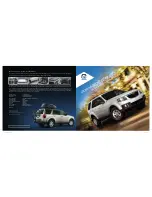
||
STARTING AND DRIVING
446
E5 is a petrol with maximum
2.7% oxygen and maximum
5 volume % ethanol.
E10 is a petrol with maximum
3.7% oxygen and maximum
10 volume % ethanol.
•
Fuel that contains up to 10 percent by
volume ethanol is permitted.
•
EN 228 E10 petrol (max 10 percent by
volume ethanol) is approved for use.
•
Ethanol higher than E10
(max. 10 percent by volume ethanol) is
not permitted, e.g. E85 is not permitted.
Octane rating
•
RON 95 can be used for normal driving.
•
RON 98 is recommended for optimum per-
formance and minimum fuel consumption.
•
An octane rating lower than RON 95 must
not be used.
When driving in temperatures above +38 °C
(100 °F), fuel with the highest octane rating is
recommended for optimum performance and fuel
economy.
•
Use only unleaded petrol to avoid damag-
ing the catalytic converter.
•
Fuel containing metallic additives must
not be used.
•
Do not use any additives which have not
been recommended by Volvo.
Related information
•
•
•
Petrol particle filter (p. 446)
•
Petrol particle filter
Petrol cars are fitted with particle filters for more
efficient emission control.
Particles in the exhaust gases are collected in
the petrol particle filter during normal driving. In
normal driving conditions, passive regeneration
takes place, which leads to the particles being
oxidised and burned away. The filter is emptied in
this way.
If the car is driven at low speed or with repeated
cold starts in low outside temperature, active
regeneration may be necessary. Regeneration of
the particulate filter is automatic and normally
takes 10-20 minutes. There may be a smell of
burning during regeneration.
Use the parking heater in cold weather - the
engine then reaches normal operating tempera-
ture more quickly.
When driving short distances at low
speeds in a petrol car
The capacity of the emissions system is affected
by how the car is driven. It is important to drive
varying distances at different speeds to achieve
optimal performance.
Driving short distances at low speeds (or in cold
climates) frequently, where the engine does not
reach normal operating temperature, can lead to
problems that can eventually cause a malfunction
and trigger a warning message. If the vehicle is
mostly driven in city traffic, it is important to regu-
Summary of Contents for V90 2019
Page 1: ...V90 OWNER S MANUAL...
Page 2: ......
Page 16: ...14 ALPHABETICAL INDEX Alphabetical Index 655...
Page 17: ...OWNER S INFORMATION...
Page 26: ......
Page 27: ...YOUR VOLVO...
Page 42: ......
Page 43: ...SAFETY...
Page 76: ......
Page 77: ...DISPLAYS AND VOICE CONTROL...
Page 148: ......
Page 149: ...LIGHTING...
Page 165: ...WINDOWS GLASS AND MIRRORS...
Page 183: ...SEATS AND STEERING WHEEL...
Page 200: ......
Page 201: ...CLIMATE...
Page 239: ...KEY LOCKS AND ALARM...
Page 259: ...KEY LOCKS AND ALARM 257 Country Area Type approval Oman Serbia...
Page 262: ...KEY LOCKS AND ALARM 260 Country Area Type approval Oman Serbia...
Page 283: ...DRIVER SUPPORT...
Page 408: ......
Page 409: ...STARTING AND DRIVING...
Page 477: ...SOUND MEDIA AND INTERNET...
Page 531: ...WHEELS AND TYRES...
Page 557: ...LOADING STORAGE AND PASSENGER COMPARTMENT...
Page 576: ......
Page 577: ...MAINTENANCE AND SERVICE...
Page 633: ...SPECIFICATIONS...
Page 673: ......
Page 674: ...TP 27165 English AT 1846 MY19 Copyright 2000 2018 Volvo Car Corporation...
















































